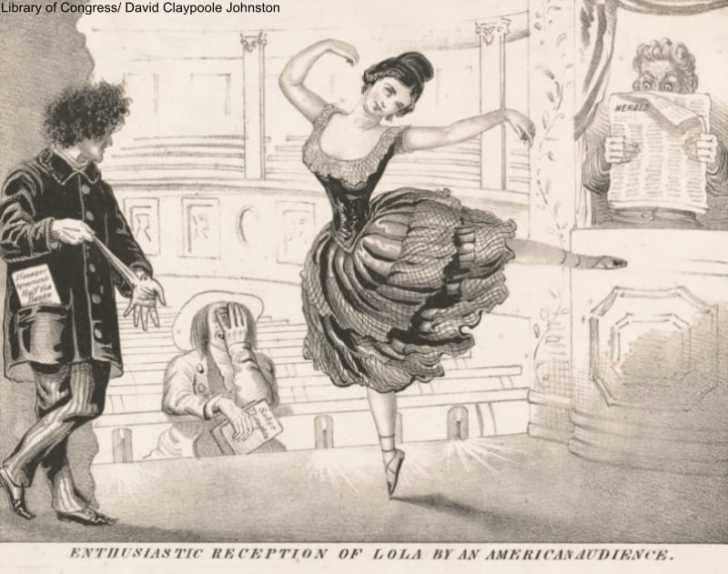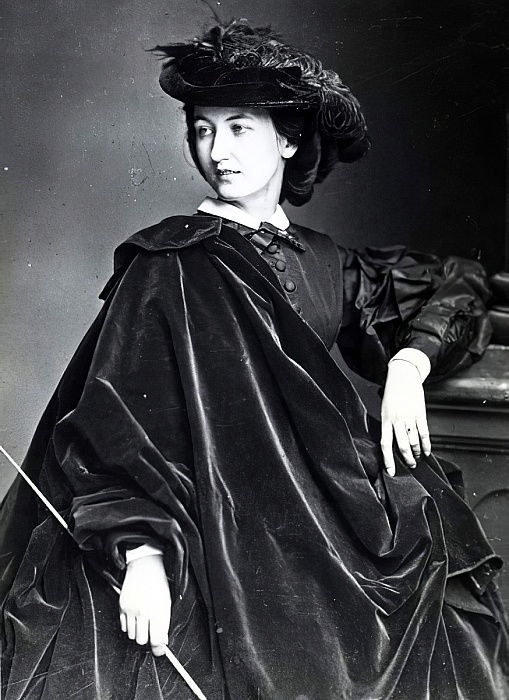
Lola Montez, is a historical figure that overflows with audacity and fascination, she was a woman who lived her life defying the social conventions of her time. Born in Grange, County Sligo, Ireland in 1821 as Eliza Rosanna Gilbert, her parents were Edward Gilbert, a British Army officer, and Eliza Oliver, the daughter of an Irish landowner. A few years after her birth, her father was sent with his family to India, where Eliza grew up. Soon tragedy comes to her life, her father dies of cholera. The following year her mother would marry another English officer, who sends his wife's teenage daughter to a Scottish school, which could tame Eliza's impulsive character.
The temperament of the future Lola Montez made it impossible to keep her in a school, she went through several schools, before running away from her and marrying, at the age of 16, Lieutenant Thomas James. Before turning 21, she would leave him, to start a career as a dancer in London. Her noble origin, and as a married woman, made her hide her true origin, creating the character of Lola Montez, a Spanish dancer. She however was recognized as "Mrs. James", so she decided to leave Great Britain, and try her luck on the Continent.

Her fame grew rapidly, along with her reputation as a seductress, her performance was a success in Paris and other large European cities where the "Spanish" presented her dance of the tarantula.
Lola's list of lovers is a veritable parade of renowned figures from the 19th century. Among them were such distinguished figures as the composer Franz Liszt and the writer Alexandre Dumas. But it was her relationship with King Ludwig I of Bavaria that immortalized her in the imagination of her time.
Lola arrived in Munich in 1846 and in a short time managed to capture the attention of the king. Ludwig or Ludwig I of Bavaria was so captivated by her beauty and her independent spirit that he made her her favorite lover. That fascination is evidenced in an unconfirmed story that describes their first meeting. Luis, after admiring her dancing, approached her and asked her in public if her breasts were real. Her response was as bold as it was unforgettable: he tore her clothes to let him admire them, proving her authenticity.
Soon the romance became the talk of the German salons and the people, who did not see that relationship with good eyes. The king went so far as to make her Countess of Landsfeld, granting him a lifetime pension from her.
The enemies of the Bavarian king used Lola as a scapegoat for all the misfortunes of the court, spreading malicious rumors about her and her influence over the king. Without a doubt, she was not another lover in the life of Luis I; she had become his adviser and confidante, but we cannot clearly know how important her influence was in the decisions the king made.
Lola was a woman from her time, marked by liberal ideas and anti-clericalism. She firmly believed in the separation of the powers of the state, in turning the kingdom into a constitutional monarchy, and above all a secular one. This provoked the ire of the Catholic conservatives, who reported that the dismissal of the Minister of State, Karl von Abel, and his entire cabinet, occurred because they opposed his naturalization and his title of countess.
In 1848, political tensions broke out, resulting in the German Revolution. Luis I abdicated in favor of his son, Maximiliano II, and Lola was forced to flee. Her time as a power figure behind the throne had come to an end.
After leaving Europe, Lola continued her career as a dancer and actress in the United States, where she was considered a diva, and as such she behaved, hitting and insulting anyone who criticized her actions.
From her passage through the United States, her house in Grass Valley, California, is preserved, a modest house, nothing comparable to the palaces in which she lived in Europe. The house is today a California Historic Landmark. Her last chance to be recognized as the Great Lola Montez was in San Francisco, where she arrived infected by the gold rush, performing in modest theaters to the delight of the nouveaux riches of North America. After two years in California, she would return to New York, already with obvious signs of suffering from syphilis, living off the charity of her friends. On January 17, 1861 she would die in New York, being buried in the Green-Wood Cemetery in Brooklyn.
The story of Lola Montez has inspired many literary works. Among them stands out the novel "Lola Montez: A Life" by Bruce Seymour, which provides an intimate and detailed portrait of this historical figure. One of the greatest writers of the 19th century, Arthur Conan Doyle, was inspired by "the Spanish" to create the character of Irene Adler, the protagonist of one of Sherlock Holmes's adventures: "A Scandal in Bohemia". In addition, her life has been recreated in several films, such as "Lola Montès" by Max Ophüls, and she has inspired the song "Whatever Lola Wants, Lola Gets" from the Broadway musical "Damn Yankees".
We must rescue, for history, the frustrated attempt by Joseph Goebbels, Hitler's Minister of Propaganda, to make a super Spanish-German production about his life, Hitler himself insisting that the protagonist be the Argentine actress, based in Spain, Empire Argentina, which was very popular in the Third Reich.